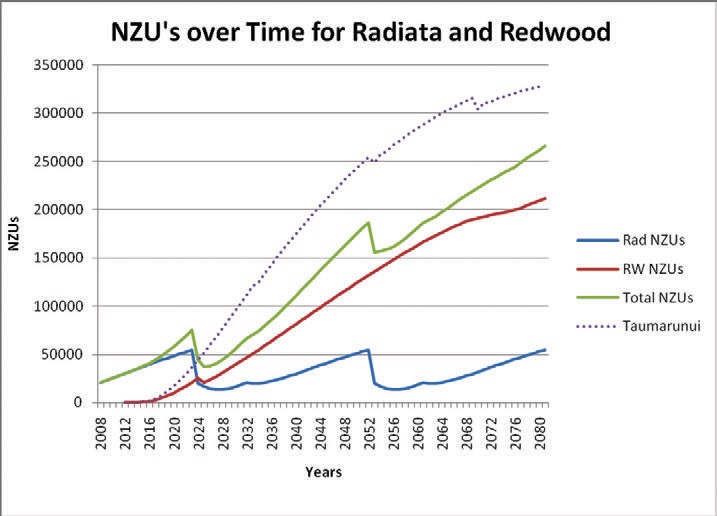Managing carbon trading risk using redwood
Paul Silcock, New Zealand Tree Grower November 2009.
Plantation grown coast redwood is a species eminently suitable for long term carbon sequestration. Other articles in this issue of Tree Grower describe the attributes that make this tree a lean, green, carbon-storage machine. This case study describes how redwood can be used to minimise risk and increase returns for current post-1989 forest owners opting into the Emissions Trading Scheme.
Outline of an example
We can consider a 50 hectare stand of radiata pine established in 1994, managed on a clearwood regime, located on an average ex-farm site and been signed up for the ETS. No credits have been traded. There is plenty of other hill country reverting to scrub above the dairy flats that could be brought into forestry and the landowner is fairly risk averse.
Given the establishment age of the forest the total carbon at 2008 is 460 tonnes of carbon dioxide equivalent per hectare. This already exceeds the risk free carbon stock per hectare remaining after harvest of 274 tonnes of carbon dioxide equivalent per hectare. The farm forester views his carbon trading prospects as too risky so a reassessment of the long term strategy is needed.
First option
For this option assume ‘a bird in hand is worth two in the bush’ so New Zealand Units (NZU’s) would be traded annually until harvest. Using the stumpage revenue to cover carbon liabilities will give a positive cash flow throughout the remainder of the rotation. This strategy seems fiscally sound assuming that carbon and clearwood timber prices remain in the ballpark.
But what if the carbon price increases during the rotation and the liability at harvest increases?
Second option
Relying on predictions for a market which has never existed could prove too much for the farm forester. He therefore decides to make an investment into a carbon reservoir to cover the liabilities of the radiata crop. Under this option enough revenue is generated by the carbon sequestered between 2008 and 2014 to establish twice the area of the existing stand in redwood.
| Radiata 50 hectares | Redwood 100 hectares | |||||
|---|---|---|---|---|---|---|
| Year | Stand age | Net NZUs | Cash flow | Stand age | Net NZUs | Cash flow |
| 2008 | 13 | 21,000 | 0 | - | - | - |
| 2012 | 17 | 30,209 | $229,830 | 0 | 0 | -$229,600 |
| 2023 | Clearfell at 28 years | -13,621 | $340,525 | 11 | 20,915 | $552,875 |
| 2053 | Clearfall at 28 years | -21,311 | -$532,775 | 41 | 115,401 | $2,885,025 |
This area of redwood then sequesters enough carbon by the harvest age of the existing radiata stand to cover all harvest liabilities. This enables the farm forester to trade all radiata carbon annually, confident that any risk is covered by the NZUs stored in the redwood, and the radiata timber revenue is not needed to cover any liability at harvest.
Analysis
Assuming a carbon price of $25 per NZU there will be a revenue of $229,830 generated from trading the NZUs from the 50 hectares of radiata between 2008-2012. This will cover the establishment cost for 100 hectares of redwood at $2,296 per hectare.
When the radiata is felled at age 28, the carbon liabilities will be 13,621 NZUs. This is calculated from 33,289 NZUs traded since 2008 less 19,668 remaining on site as harvest and residue.

The liabilities will be covered by trading the 20,915 NZUs held in the 100 hectares of redwood. All radiata credits of 54,678 can then be traded throughout the second rotation. The NZUs held in the redwood stand − 136,316 less the 20,915 traded for the first radiata harvest − will again cover the radiata liabilities at harvest of minus 21,311. No stumpage returns have been considered in this example.
The graph shows where the ability of redwood to carry high volumes of timber per hectare becomes evident. By 2032 at age 20, the 100 hectare stand of redwood will have sequestered as much carbon as the 28-year-old 50 hectare radiata stand and over twice the carbon stocks in reserve by the end of the second radiata rotation. By 2052 the redwood volume will be standing at 1,323 cubic metres a hectare and average an increment of 30 cubic metres a hectare each year.
The assumptions are conservative when compared with data from an 86-year-old stand near Taumarunui. This is currently putting on over 40 cubic metres a hectare each year and standing at 3,664 cubic metres per hectare. If is considered an average productivity site for North Island New Zealand conditions.
Worth thinking about
Risk management for carbon forestry is a relatively new field where minimal trading of risk-free credits, normalising a forest age structure, carbon pooling or investing in some type of insurance are among suggested practices. For the small forest owner planting more trees is another good way.
Using returns from carbon trading to establish further forest area and reduce any risk associated with liabilities has been shown to work in this basic analysis. Risk is reduced by spreading age classes and diversifying species, providing a balance to cover the liabilities for short rotation species in times of harvest or disaster. Redwood is a species suitable for this process as it has the ability to sequester sufficient carbon in the early years and carry huge amounts of carbon later in the rotation. Other options such as trading the redwood carbon and selective harvesting for continuous cover forestry are all feasible and will no doubt be looked into as carbon forestry management matures.

 Farm Forestry New Zealand
Farm Forestry New Zealand